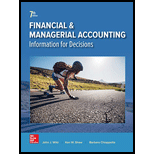
Lump Sum Purchase:
When the assets are purchased or bought in a lot in one transaction at a lump sum price that is called lump sum purchase. In lump sum purchase, apportion cost of purchase on the basis of relative market value can be anticipated by appraisal.
To Identify: The apportioned cost.
Answer to Problem 1MCQ
‘Option b, Land, $163,000; land improvements, $60,000; building, $97,800.’ is correct.
Explanation of Solution
Given,
Land appraised value is $175,000.
Land improvements appraised value is $70,000.
Buildings appraised value is $105,000.
Total amount paid by the company is 326,000.
Formula of total appraised value:
Substitute $175,000 as the appraised value of land, $70,000 as the appraised value of land improvements and $105,000 as the appraised value of the building in the above formula,
Total appraised value is $350,000
Percentage of total
Formula to calculate percentage of total:
Land
Substitute $175,000 as the appraised value of land and $350,000 as the total appraised value in the above formula,
Percentage of land is 50%
Land improvements
Substitute $70,000 as the appraised value of land improvements and $350,000 as the total appraised value,
Percentage of land improvements is 20%.
Building
Substitute $105,000 as the appraised value of the building and $350,000 as the total appraised value.
Percentage of building is 30%.
Apportioned cost
Given,
Total amount paid is $326,000
Formula to calculate Apportioned cost:
Land
Substitute 50% as the percentage of total for land and $326,000 as amount paid,
Apportioned cost of land is $163,000.
Land Improvements
Substitute 20% as the percentage of total for land improvements and $326,000 as amount paid,
Apportioned cost of land improvements is $65,200.
Building
Substitute 30% as the percentage of total for building and $326,000 as amount paid,
Apportioned cost of building is $97,800.
Hence, therefore the answer is ‘option b’.
Want to see more full solutions like this?
Chapter 8 Solutions
Financial and Managerial Accounting
- I am looking for a reliable way to solve this financial accounting problem using accurate principles.arrow_forwardI need help with this financial accounting problem using proper accounting guidelines.arrow_forwardCan you demonstrate the accurate steps for solving this financial accounting problem with valid procedures?arrow_forward
- I am looking for the correct answer to this general accounting question with appropriate explanations.arrow_forwardI am looking for help with this general accounting question using proper accounting standards.arrow_forwardI need assistance with this general accounting question using appropriate principles.arrow_forward
- Please show me the correct approach to solving this financial accounting question with proper techniques.arrow_forwardPlease provide the solution to this general accounting question using proper accounting principles.arrow_forwardI need help finding the correct solution to this financial accounting problem with valid methods.arrow_forward
- Please explain the solution to this financial accounting problem using the correct financial principles.arrow_forwardCan you solve this general accounting problem with appropriate steps and explanations?arrow_forwardPlease provide the correct answer to this financial accounting problem using valid calculations.arrow_forward

 AccountingAccountingISBN:9781337272094Author:WARREN, Carl S., Reeve, James M., Duchac, Jonathan E.Publisher:Cengage Learning,
AccountingAccountingISBN:9781337272094Author:WARREN, Carl S., Reeve, James M., Duchac, Jonathan E.Publisher:Cengage Learning, Accounting Information SystemsAccountingISBN:9781337619202Author:Hall, James A.Publisher:Cengage Learning,
Accounting Information SystemsAccountingISBN:9781337619202Author:Hall, James A.Publisher:Cengage Learning, Horngren's Cost Accounting: A Managerial Emphasis...AccountingISBN:9780134475585Author:Srikant M. Datar, Madhav V. RajanPublisher:PEARSON
Horngren's Cost Accounting: A Managerial Emphasis...AccountingISBN:9780134475585Author:Srikant M. Datar, Madhav V. RajanPublisher:PEARSON Intermediate AccountingAccountingISBN:9781259722660Author:J. David Spiceland, Mark W. Nelson, Wayne M ThomasPublisher:McGraw-Hill Education
Intermediate AccountingAccountingISBN:9781259722660Author:J. David Spiceland, Mark W. Nelson, Wayne M ThomasPublisher:McGraw-Hill Education Financial and Managerial AccountingAccountingISBN:9781259726705Author:John J Wild, Ken W. Shaw, Barbara Chiappetta Fundamental Accounting PrinciplesPublisher:McGraw-Hill Education
Financial and Managerial AccountingAccountingISBN:9781259726705Author:John J Wild, Ken W. Shaw, Barbara Chiappetta Fundamental Accounting PrinciplesPublisher:McGraw-Hill Education





